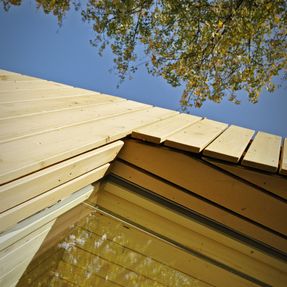Trek-In Hicker’s Cabins
PHOTOGRAPHS
Tim van der Grinten
LOCATION
The Netherlands
PROJECT WEBSITE
www.trek-in.org
YEAR
2012
BUILDING COMPANY
2Life-Art | www.2life-art.nl
ARCHITECTS
MoodBuilders, Kristel Hermans Architectuur
CATEGORY
Cabins & Lodges, Adaptive Reuse
RE USED MATERIALS
A van Liempd Sloopbedrijven (demolition contractor) | www.avanliempd.nl
CLIENTS
Stichting Natuurkampeerterreinen (the Dutch coordinating organization of natural campsites) | www.natuurkampeerterreinen.nl/en/
Text description provided by architect
The Trek-in is a sustainable hiker’s cabin, featuring responsible and luxurious camping, experiencing the surroundings and an original, minimalist design.
Trek-in cabins are light, spacious, and made from sustainable/re-usable materials and demolition waste.
The large windows at the front and back of the cabin bring nature right into the living environment. This creates a unique atmosphere for each of the nine current locations were a Trek-in can be found in the Netherlands.
Architype shapes of the house and tent were mixed with the interior spaces into the final shape of the design. This results in a cabin that is both different and unique, but also familiar for many.
The sustainable hiker’s cabins are equipped with a bathroom (including a shower, toilet, and washbasin) and a fully-fitted kitchen featuring a two-burner or three-burner stove, refrigerator, running water and a range of kitchen utensils.
Trek-in cabins sleep four to six and feature two double beds and a sofa bed.
To entertain the young ones, there’s Simon Stork (“Otto Ooievaar”), who introduces children to sustainability and lets them discover the natural world in a fun, yet educational way.
For example, they learn how to re-use waste, as the building itself is made of 'demolition waste'.
Although it is not visible at first sight, the Trek-in is made of reclaimed materials from demolition projects; building materials as wood and insulation, but also smaller interior parts as the light switches and curtain rails are re-used.
Hardly any new materials are needed. The materials history gives each Trek-in a personal story which is documented in the certificate of origin that is accompanied by a Trek-in.
The Trek-in was designed as part of a competition at the Department of the built environment of Eindhoven University of Technology (TU/e), in the Netherlands, in 2010.
Tim van der Grinten & Xaviera Burón Klose were elected as winners of this competition. In a team of six students, they developed a definitive design under supervision of TU/e teachers. With this design, the students won a national competition for innovative designs made out of wood, the WoodChallenge.
In this part of the project Kristel Hermans (building engineering) became a valuable team member. Tim, Xaviera and Kristel took the definitive design into the next phase und the supervision of Faas Moonen.
They elaborated the design for realisation. The prototype was officially presented at the Dutch Design Week 2012 in Eindhoven.
After this period both Tim van der Grinten (MoodWorks Architecture) and Kristel Hermans (Kristel Hermans Architectuur) kept on developing the Trek-in concept.
This also resulted in the design of the Trek-in Junior; a smaller version of the Trek-in that can be fully prefabricated and transported in one single piece, while the larger Trek-in is prefabricated in two modules.
The Trek-in and Trek-in Junior are incorporated in the network of natural campsites and are intented to be available on many more locations in the future. MoodWorks Architecture and Kristel Hermans Architecture are currently teaming up on developing more product development projects.
Their passion is in designing moveable, flexible, sustainable architecture with a focus on space, sense of security and connection with nature.





























